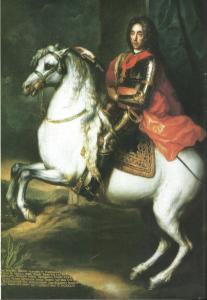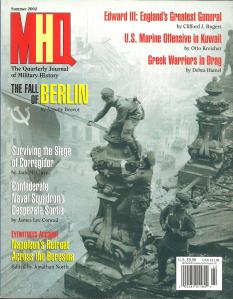Military History Quarterly Summer 2002
Prince Eugene’s Balkan Masterpiece
By Ludwig Heinrich Dyck

In 1697, the Second Great Turkish War had been going on for fourteen years. In it the Holy League – a coalition composed of the Holy Roman Empire, Poland, Venice and Russia, was arrayed against the vast empire of the Ottoman Turks. Although the war had begun promisingly for the Europeans, the intervening Nine Years War (1688-97) against the belligerent Louis XIV, the Sun King of France, allowed the Turks time to recover. The Ottomans re-conquered lost lands and were further inspired by the personal bravery of their new Sultan, Mustafa II (r. 1695-1703).
After the fighting against the French came to an end, the Holy Roman Empire prepared to regain the initiative against the Turks. However, just before the summer campaigning season of 1697, the commander of the Imperial army, the flamboyant Frederick Augustus “the Strong” of Saxony, entered the election of the vacant Polish throne. He left the army in the hands of his second in command, Prince Eugene of Savoy, a veteran of the Turkish and French wars.
“Eugene, trained as a scholar, was of Italian heritage and French upbringing. His mother, Olympia Mancini, wife of the late duke of Savoy, had been involved in many illicit love affairs at the court of Louis XIV until she was banished from France for dabbling in potions and magic. Physically unimposing and burdened with his mother’s scandalous legacy, Eugene seemed a poor candidate for a military career, and Louis denied his request to join the French army. The young nobleman, however, was determined to follow the martial footsteps of his father and defected from France to join the Imperial army of Holy Roman Emperor Leopold I prior to the 1683 Battle of Vienna.”
“Wholly devoted to his military career and wounded several times, Eugene was steadily promoted and earned the rank of field marshal in 1693 at thirty years of age.”
“As it was too late to chose a new commander-in-chief, Eugene was left in sole command of the Imperial army in Hungary. Early in July he joined his troops, who were drawn up with their regimental and Imperial standards at Esseg (Osjek) to greet their new commander. To the Austrian, Saxon and Brandenburg soldiers, the puny Eugene, in his plain brown coat instead of the usual pearl gray and gold trimmed officer’s tunic, must have contrasted sharply with their former commander. But what Eugene lacked in appearance, he more than made up for in character. Upon being informed that his army numbered only 31, 142, he replied: “Thank you for the information. I am the 31, 143rd, and soon we shall have more.”
“On August 19 the Turks crossed the Danube at Pancsova. Brimming with confidence, Sultan Mustafa’s one-hundred-thousand-man army was followed by cartloads of chains with which they planned to bind the defeated German generals and soldiers.”
Late in the day, on September 11th, 1697, Prince Eugene reconnoitered with his hussars on the high ground above the burnt village of Zenta. From there he beheld the Ottoman army in the process of crossing the river Tisza.
“Below him, just to the south of the village, the bulk of the Turkish infantry, along with seventy pieces of artillery and a handful of sipâhî (Ottoman noble and regular cavalry), remained on the west of the Tisza. An incomplete semicircle of ramparts, wagon barricades, and ditches protected the troops as well as the bridgehead.”
“The Imperial army arrived at Zenta with only a few hours of daylight left. Although his troops were exhausted from another forced march, Eugene immediately deployed his arriving columns for an attack.”
“Like madmen the Imperial troops stormed the ramparts, engaging the Turks at close quarters. The Ottomans, in turn, threw down their muskets to slash about with their sabers.”
The decisive battle of Zenta established Prince Eugene as one of Europe’s leading commanders. Ludwig H. Dyck’s article “Prince Eugene’s Balkan Masterpiece,” is featured in Military History Quarterly Summer 2002 issue.

